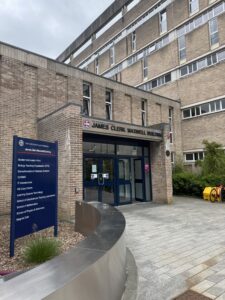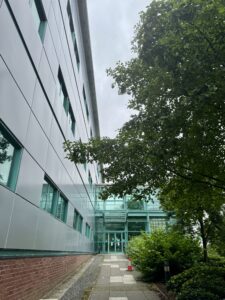Xia Peisu Training Room, James Clerk Maxwell Building
Xia Peisu was a Chinese computer scientist, hailed as “the mother of computer science in China”. In 1941, Xia matriculated at the National Central University, to study electrical engineering. This was during the Second Sino-Japanese War, with the National Central University relocated after the Japanese capture of Nanjing. Xia graduated in 1945 and went on to study for a PhD at the University of Edinburgh in 1947.
Xia returned to China in 1951, during the beginning of the Cold War. The Chinese Communist Party began a coalition with the Soviet Union, who assisted China’s scientific and technological advancement. Xia became involved in this work, recruited to lead the development of China’s first general-purpose electronic computer.
In 1960, the Sino-Soviet partnership dissolved, and many assumed this development would end. However, despite two of her colleagues leaving the project, Xia completed Model 107, China’s first indigenously designed computer.

Xia went on to become a founding professor at the Institute of Computing Technology, established two journals, and wrote the first systematic computer science textbook in China. Xia also taught China’s first course in computer theory and was elected as an academician of the Chinese Academy of Sciences. The Xia Peisu Training Room in the James Clerk Maxwell Building was named after her, and her many contributions to computer science.
Max Born Crescent
Max Born was a German-British physicist who helped found quantum mechanics and was awarded the Nobel Prize in 1954. Born into a Jewish family, he was suspended from his professorship at the University of Göttingen in 1933 following the rise of the Nazi party. Born, now a refugee, took up a post at Cambridge University, and became stateless in 1935 when his German citizenship was revoked.
His position at Cambridge was temporary and so he considered an offer from Moscow, even taking Russian lessons, but was offered Edinburgh’s Tait professorship in 1936, which he promptly accepted. He became a naturalised citizen just one day before WWII broke out.
Klaus Fuchs, a German refugee working alongside Born at Edinburgh University was not so lucky. His citizenship application had not been processed before WWII began. Born attempted to prove his assistant was not an enemy alien, providing a reference that said he was anti-Nazi. Nevertheless, Fuchs was taken into custody and interned on the Isle of Man, and then in Canada for a year.
Born successfully lobbied for his release and Fuchs returned to work for him in Edinburgh in 1941. However, in 1950 Fuchs was convicted of supplying information from the American, British, and Canadian Manhattan Project to the Soviet Union, during and after WWII.
Born later employed another German displaced from his home (E. Walter Kellermann), and helped many of his friends and relatives flee Germany. Born’s wife, Hedi Ehrenberg, founded a domestic bureau to find work for young Jewish women in the UK.
Born made Edinburgh his home from 1936 until 1952 when he retired aged 70. His granddaughter was the singer Dame Olivia Newton-John.
Edmund Hirst Laboratory, Christina Miller Building
Geoff Palmer was a Jamaican – British brewing chemist, life scientist and human rights activist. He was born in Jamaica in 1940, and moved to London in 1955. Palmer studied botany at undergraduate level, and was later accepted to study a PhD in grain science, jointly between the University of Edinburgh and Heriot-Watt University. His supervisor in Edinburgh was the chemist Edmund Hirst, who has a laboratory named after him in the Christina Miller Building.

Palmer’s research career was extensive, discovering the barley abrasion process, and establishing the International Centre for Brewing and Distilling. In 1985, Heriot Watt awarded him a Doctor of Science, and he was made professor in 1989. This made Palmer the first Black professor in Scotland, an achievement reached only 36 years ago.
Palmer was a recognised world authority on the Atlantic slave trade. He authored “The Enlightenment Abolished: Citizens of Britishness”, a book on Scotland’s history of slavery. He served as Honorary President of the Edinburgh and Lothian’s Regional Equality Council (ELREC), an organisation dedicated to combating discrimination and promoting equality.
Sadly, Palmer passed away aged 85 in June 2025.
Noreen and Kenneth Murray Library
Noreen Murray was an English geneticist, and pioneer of genetic engineering. Murray and her husband (Sir Kenneth Murray) together developed the first genetically engineered vaccine approved for human use, against hepatitis B. The couple established the Darwin Trust of Edinburgh to which they donated the royalty earnings from the hepatitis B vaccine.
This Trust has provided funds to construct the University of Edinburgh Darwin Library and Michael Swann Building, as well as provided numerous bursaries to support students from overseas to study in Edinburgh.
Murray’s work shaped all areas of biology and her pioneering contributions to the field were recognised internationally. She received honorary degrees from the Universities of Warwick, Manchester, Birmingham, and Lancaster. She held a personal chair at Edinburgh, was president of the Genetical Society, and vice president of the Royal Society.
Murray was also known to be a great mentor to other female scientists, a fact which her obituary highlighted: “Noreen was particularly attentive to the careers of her female colleagues and delighted in their success.”
The University named a library after the Murrays, and planted a memorial tree opposite. However, the tree was moved to an unknown location during the building of the Nucleus.
This was an excerpt from Katherine Scott and Katie Grieve’s book, “Edinburgh Historic Walks: A Summary of Hidden Histories”


